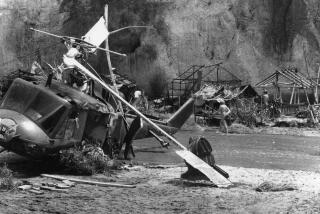Lawyer Defends FAA at Aeromexico Crash Trial
- Share via
A failure by the pilots to remain attentive to other aircraft led to the deaths of 82 people in the 1986 collision of a light plane and an Aeromexico jetliner over Cerritos, a government lawyer charged Thursday.
In his closing argument before a federal court jury, Steven Riegel, an attorney for the United States, sought to deflect fault from the Federal Aviation Administration, whose air traffic controller was on duty when the Aeromexico DC-9 and a Piper Archer collided at 11:52 a.m. on Aug. 31, 1986.
Relatives of those killed in the crash put most of the blame on the FAA because controller Walter White failed to issue any warning to the two planes before impact. White contends the Piper Archer, piloted by William Kramer, never appeared on his radar screen.
But Riegel said experts have concluded that Kramer and the Aeromexico pilots should have seen each other because visibility was “unlimited” on that sunny morning and because pilots are taught to “see-and-avoid” each other.
Kramer, 53, of Palos Verdes, must also be blamed for straying without clearance into the crowded, restricted airspace over Los Angeles International Airport, Riegel argued.
“The slightest evasive action in the last few minutes by either of those planes and none of us would be in this courtroom today,” Riegel told the jury as the five-month trial neared its end.
The crash was the worst air disaster in Los Angeles history, killing Kramer, his wife and daughter, all 64 people on the Aeromexico jet and 15 people in the Cerritos neighborhood where the planes hit the ground.
The case is expected to go to the jury today. The panel will decide the liability of Kramer and render only advisory verdicts as to the blame of the FAA and Aeromexico. Damages will be determined in later trials or settlement talks.
Riegel said pilots are instructed not to rely on air traffic controllers to avert collisions because the controllers might be preoccupied with higher-priority duties and because not all planes will appear on their radar screens.
The “see-and-avoid” doctrine, employed by vigilant pilots, is the only reliable way to avoid midair collisions, Riegel said.
Kramer’s four surviving children contend he suffered a heart attack right before the crash. Riegel and Frank Silane, Aeromexico’s lawyer, both dismissed that claim as unproven.
Silane, in his closing remarks, defended the actions of the Aeromexico crew and contended they could have been saved if White had issued a warning.
“The Aeromexico crew were doing exactly what they were supposed to do exactly when they were supposed to be doing it and they cannot be held liable,” he said.
“Mr. White made a mistake the average air controller shouldn’t have made,” Silane said. “The (air traffic control area) was created specifically to protect aircraft like this DC-9 from accidents just like this, and it didn’t.”
Air traffic controllers are critical because the “see-and-avoid” concept has “severe limitations,” Silane said. He cited a study that found pilots see approaching planes only 46% of the time.
“It shows it’s difficult to see an object in space,” he said. “It shows the likelihood that the pilot will see something is random. You don’t have to be negligent not to see another aircraft coming in.”
More to Read
Inside the business of entertainment
The Wide Shot brings you news, analysis and insights on everything from streaming wars to production — and what it all means for the future.
You may occasionally receive promotional content from the Los Angeles Times.










